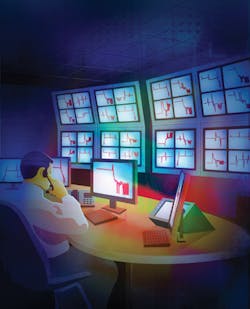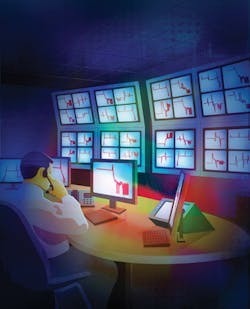By ULRICH KOHN
Access link monitoring can bring new reliability to optical access networks, unlocking a variety of new services.
Access has long loomed as optical fiber's last, great, unconquered frontier. But it's now clear that fiber's role in access networks in multiple parts of the world is growing rapidly more pervasive every day. Long undersubscribed, optical access infrastructure is today in prime demand.
As reliance on fiber for access to radio towers and customer locations has intensified, service interruptions associated with optical access have become more consequential and costly. In turn, the pressure to protect access fiber and the highly valued services traversing it has begun to climb. Access link monitoring (ALM) is a timely new concept for the task, and it figures to pave the way for even wider-scale adoption of optics in the access in ways that meet stringent cost and scalability requirements.
Shift toward fiber for access
There can be no more denying that copper fails to meet the complex and growing bandwidth and service demands of business and residential users globally. Similarly, mobile operators have come to understand that the bandwidth requirements of their base stations can't be dependably and cost-efficiently met by microwave alone, which demands frequent upgrades for any higher capacity needs.
That leaves massively scalable and reliable fiber; as a result, network operators have rolled out optical fiber to an ever-increasing share of network endpoints. Residential users enjoy the ability to download high definition movies in less than a minute and full TV shows or dozens of songs in mere seconds. Businesses value the ability to back up their mission-critical data to the cloud and across multiple locations and use video conferencing more extensively. Many business managers now also wonder what new business models and innovations might be unlocked by wider-scale access at significantly higher speeds. Furthermore, fiber installation frequently has become part of the infrastructure projects of utilities and municipalities as well.
This trend toward optics in access is evidenced globally.
Google, for example, appears that it might have designs on evolving into a full-blown telecommunications operator in the United States - or at least in bringing fiber-based services for broadband access to enough U.S. markets that other network operators feel the competitive pressure to introduce cost-effective, higher-speed access to more Internet users, too. AT&T, meanwhile, has announced a major initiative to expand its ultra-fast fiber network to up to 100 candidate cities and municipalities across the United States.
In the United Kingdom, BT has said that its open fiber network now passes about two-thirds of the homes and businesses in the country, lending credence that the government's goal of ensuring high-speed (or "superfast") access to 95% of the U.K. by the year 2017 can be achieved.
Among the 34 developed countries in the Organization for Economic Co-operation and Development (OECD), fiber was reported to account for 15.75% of fixed broadband subscriptions as of June 2013. "Two-digit annual growth in fiber was sustained thanks to increases in large OECD economies with low penetration levels such as France (32% in 6 months), Spain (34%), Turkey (33%), and the United Kingdom (47%)," read a January 9, 2014 report from the OECD. "Japan and Korea remain the OECD leaders, with fiber making up 68.45% and 62.76% of fixed broadband connections."
On a variety of fronts, signs indicate an intensifying trend toward more and more sites worldwide becoming connected via optical fiber.
Dark fiber services challenges
In the business services context of fiber's expansion, there are different flavors of connectivity services:
• Managed bandwidth such as Ethernet private lines or Layer 2/Layer 3 virtual private networks (VPNs).
• Leased lines, including leased wavelengths or optical channel data units (ODUs).
• Simple dark or dim fiber.
While network operators are typically more interested in offering higher-value services such as VPNs, there are a number of scenarios more favorably addressed with dark fiber.
One example is the mobile operator that seeks the cost advantages of a centralized radio access network (C-RAN) architecture. In a C-RAN deployment, centrally pooled baseband units are connected to lightweight, simplistic remote radio head technology at the antenna site, so complicated processing is more cost-effectively concentrated within the network. Common public radio interfaces (CPRIs) are applied to connect the pooling site and antenna site. The CPRI interface and the digitized analog radio signal that goes across it are both delay and jitter sensitive - and therefore best transported over transparent wavelengths or direct fiber connections. Hence, the mobile operator is interested in leasing dark fiber from a fiber provider.
Another scenario that tends to favor dark fiber connectivity involves infrastructure companies like utilities or municipalities that might own fiber but frequently do not want to invest in a communications network. Offering dark fiber services is an obvious business opportunity that enables the utilities or municipalities to create business value from their fiber assets. Within customer organizations, there is frequently a split between the unit responsible for operating the fiber infrastructure and the unit responsible for putting traffic onto the fiber. However, each unit is keen on managing and monitoring the service that it provides to the other.
Unfortunately, the fiber infrastructure operator often has no means to assure the availability of the purely passive service. On the other hand, the fiber operator could create more value by leasing a monitored fiber service if real time information on the integrity of its fiber could be provided, enabling a faster localization of failures and resolving questions about responsibility of failures.
New concept for today's requirements
ALM is a novel approach to optical connectivity assurance for fiber-based access and dark fiber services that operates completely separately from the transmission system using the fiber. While fiber monitoring is frequently done reactively by field services staff using optical time domain reflectometers (OTDRs), ALM extends this methodology and optimizes it for low cost, high volume applications in access networks. Service providers benefit from continuous out-of-band and in-service monitoring of their increasingly important access and dark fiber links.
No matter how many customer services are multiplexed across the network, service providers can use ALM to maintain a steady assessment of the health of their optical access infrastructures. The impact for service providers is meaningful: faster repair cycles with no interference to other customers' traffic, which translates into improved service quality and, hence, higher revenue from their dark fiber offering.
Independent of services, equipment, data rates, data formats, and protocols, ALM requires a processor module for multiple fibers in the central office (CO) or headend, one passive coupler per access fiber in the CO/headend, and one wavelength-selective optical reflector per access fiber in the customer premises equipment (CPE) or far end. A low cost OTDR with passive, transparent optical demarcation enables ALM to monitor multiple in-service fibers.
This monitoring of the fiber enables early recognition of the fiber stress that affects fiber attenuation and frequently leads to fiber breaks. Service providers can thus initiate preemptive counteraction before services are disrupted (see Figure 1).
The integrity of the fiber is monitored by measuring the reflection of an optical signal that's coupled into the access fiber (see Figure 2). The optical power of the reflection from the point of demarcation is monitored, and the intensity of the reflected demarcation peak provides an estimate of the insertion loss of the link. A reduction in the demarcation reflection peak can indicate a fiber cut or increased insert loss; measuring the Rayleigh scattering can detect the location of a potential fiber cut. In this way, ALM delivers immediate failure identification and localization through optical layer demarcation and simplified root cause analysis, thereby fueling faster repair cycles and improved fiber availability.
Just in time
ALM provides an efficient, unobtrusive approach that allows network operators to create more value from their fiber assets. Completely independent from the applications running over the fiber - which might be 100G Ethernet traffic, special interfaces for interconnecting data centers, or even analog optical cable TV systems - ALM delivers out-of-band, in-service real time monitoring, fault detection, and fault localization optimized for fiber-based access and dark fiber services.
Optical offers the clear, futureproofing answer to the ever-escalating bandwidth demands now placed upon access infrastructures. With fiber access rising rapidly around the world, ALM is a timely addition to network operators' arsenal of capabilities.
ULRICH KOHN is director of technical marketing at ADVA Optical Networking.
Archived Lightwave Issues



